1996 HONDA ODYSSEY cooling
[x] Cancel search: coolingPage 152 of 240
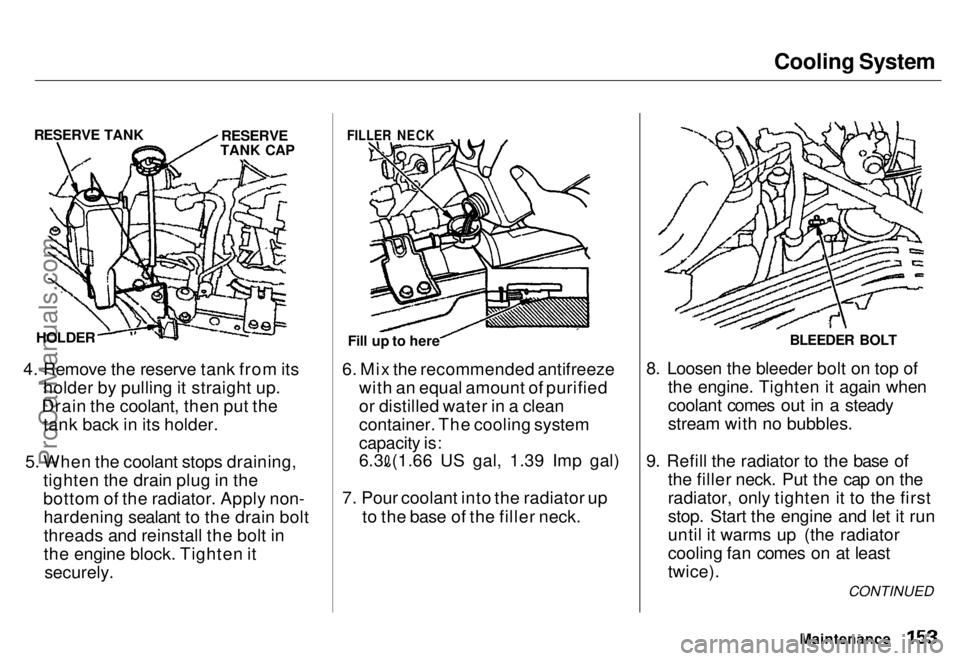
Cooling System
RESERVE TANK
RESERVE
TANK CAP
HOLDER
4. Remove the reserve tank from its holder by pulling it straight up.
Drain the coolant, then put the tank back in its holder.
5. When the coolant stops draining, tighten the drain plug in the
bottom of the radiator. Apply non-hardening sealant to the drain bolt
threads and reinstall the bolt in
the engine block. Tighten it securely.
FILLER NECK
Fill up to here
6. Mix the recommended antifreeze with an equal amount of purified
or distilled water in a clean
container. The cooling system
capacity is:6.3 (1.66 US gal, 1.39 Imp gal)
7. Pour coolant into the radiator up
to the base of the filler neck. BLEEDER BOLT
8. Loosen the bleeder bolt on top of the engine. Tighten it again when
coolant comes out in a steady
stream with no bubbles.
9. Refill the radiator to the base of the filler neck. Put the cap on the
radiator, only tighten it to the first
stop. Start the engine and let it run
until it warms up (the radiator
cooling fan comes on at least
twice).
MaintenanceCONTINUED
ProCarManuals.comMain Menu s t Table of Contents
Page 153 of 240
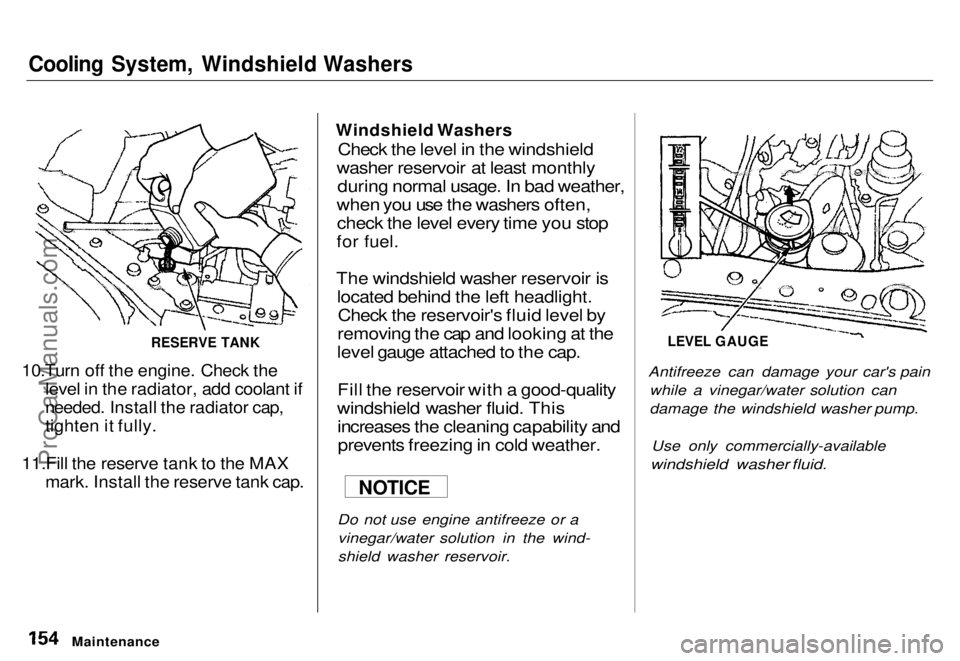
Cooling System, Windshield Washers
10.Turn off the engine. Check the
level in the radiator, add coolant if
needed. Install the radiator cap,
tighten it fully.
11.Fill the reserve tank to the MAX
mark. Install the reserve tank cap.
Windshield Washers
Check the level in the windshield
washer reservoir at least monthly during normal usage. In bad weather,
when you use the washers often, check the level every time you stop
for fuel.
The windshield washer reservoir is located behind the left headlight.Check the reservoir's fluid level by
removing the cap and looking at the
level gauge attached to the cap.
Fill the reservoir with a good-quality
windshield washer fluid. This increases the cleaning capability andprevents freezing in cold weather.
Do not use engine antifreeze or a vinegar/water solution in the wind-
shield washer reservoir.
LEVEL GAUGE
Antifreeze can damage your car's pain while a vinegar/water solution can
damage the windshield washer pump.
Use only commercially-available
windshield washer fluid.
Maintenance
RESERVE TANK
NOTICEProCarManuals.comMain Menu s t Table of Contents
Page 167 of 240
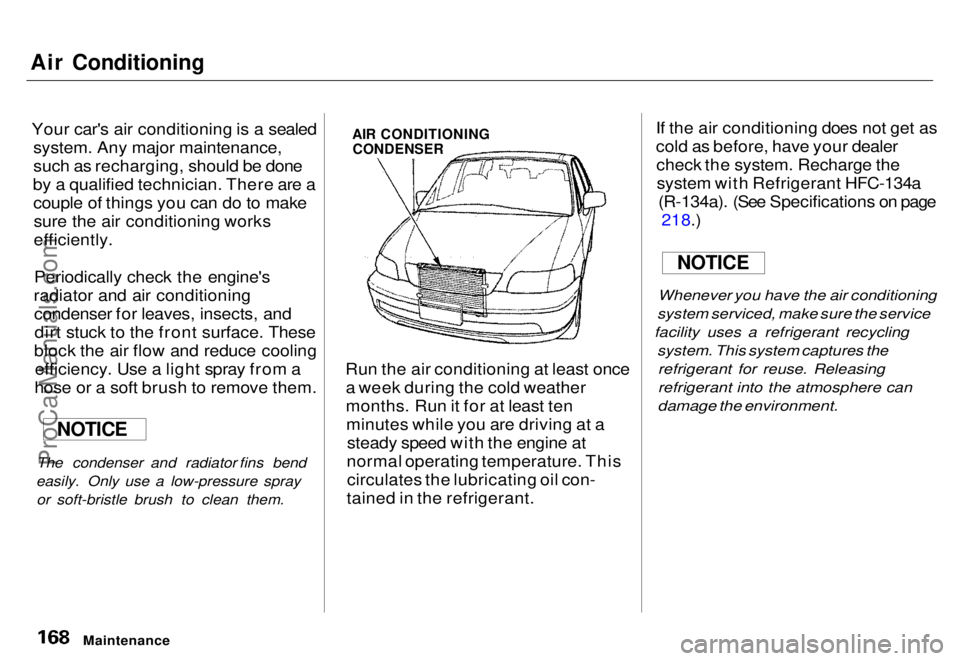
Air Conditioning
Your car's air conditioning is a sealed system. Any major maintenance,
such as recharging, should be done
by a qualified technician. There are a couple of things you can do to makesure the air conditioning works
efficiently.
Periodically check the engine's
radiator and air conditioning condenser for leaves, insects, anddirt stuck to the front surface. These
block the air flow and reduce cooling efficiency. Use a light spray from a
hose or a soft brush to remove them.
The condenser and radiator fins bend
easily. Only use a low-pressure spray or soft-bristle brush to clean them.
AIR CONDITIONING
CONDENSER
Run the air conditioning at least once a week during the cold weather
months. Run it for at least tenminutes while you are driving at a steady speed with the engine at
normal operating temperature. This circulates the lubricating oil con-
tained in the refrigerant. If the air conditioning does not get as
cold as before, have your dealer
check the system. Recharge thesystem with Refrigerant HFC-134a (R-134a). (See Specifications on page 218.)
Whenever you have the air conditioning
system serviced, make sure the service
facility uses a refrigerant recycling
system. This system captures the
refrigerant for reuse. Releasing
refrigerant into the atmosphere can
damage the environment.
Maintenance
NOTICE
NOTICEProCarManuals.comMain Menu s t Table of Contents
Page 200 of 240
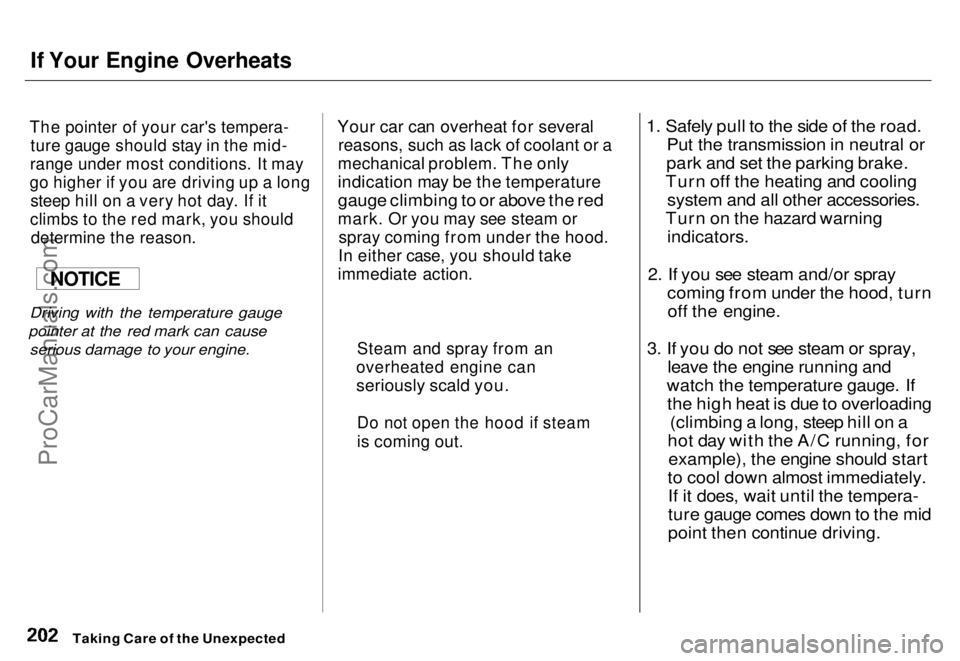
If Your Engine Overheats
The pointer of your car's tempera-
ture gauge should stay in the mid-
range under most conditions. It may
go higher if you are driving up a long
steep hill on a very hot day. If it
climbs to the red mark, you should
determine the reason.
Driving with the temperature gauge
pointer at the red mark can cause serious damage to your engine.
Your car can overheat for several
reasons, such as lack of coolant or a
mechanical problem. The only
indication may be the temperature
gauge climbing to or above the red
mark. Or you may see steam or
spray coming from under the hood.
In either case, you should take
immediate action.
1. Safely pull to the side of the road.
Put the transmission in neutral or
park and set the parking brake.
Turn off the heating and cooling system and all other accessories.
Turn on the hazard warning indicators.
2. If you see steam and/or spray coming from under the hood, turnoff the engine.
3. If you do not see steam or spray, leave the engine running and
watch the temperature gauge. If the high heat is due to overloading (climbing a long, steep hill on a
hot day with the A/C running, for example), the engine should start
to cool down almost immediately. If it does, wait until the tempera-
ture gauge comes down to the mid
point then continue driving.
Taking Care of the Unexpected
NOTICE
Steam and spray from an
overheated engine can
seriously scald you.
Do not open the hood if steam
is coming out.ProCarManuals.coms t Main Menu Table of Contents
Page 201 of 240
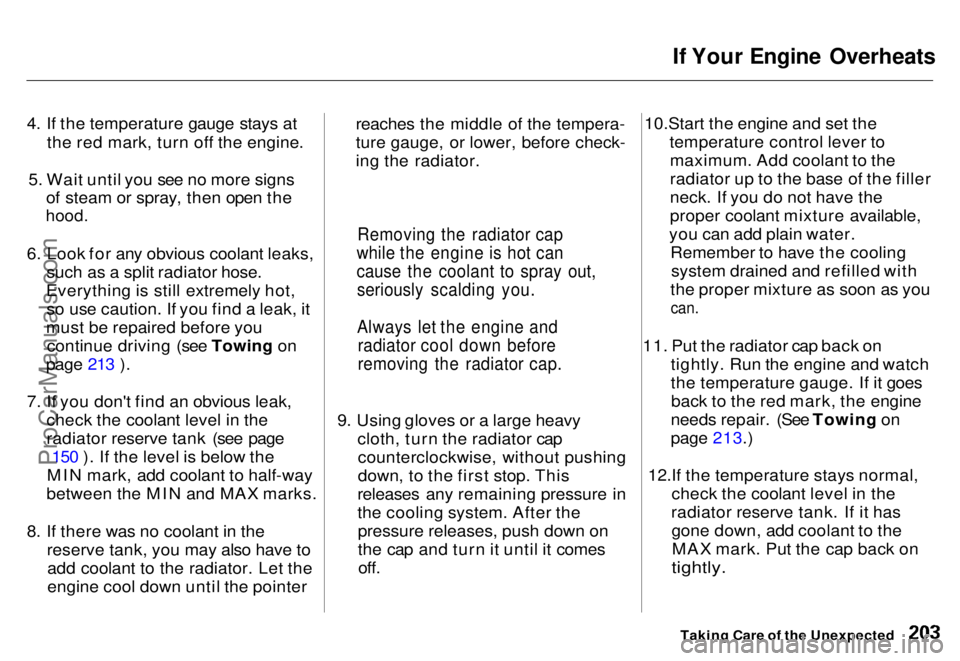
If Your Engine Overheats
4. If the temperature gauge stays at the red mark, turn off the engine.
5. Wait until you see no more signs of steam or spray, then open the
hood.
6. Look for any obvious coolant leaks, such as a split radiator hose.
Everything is still extremely hot, so use caution. If you find a leak, it
must be repaired before you continue driving (see Towing on
page 213 ).
7. If you don't find an obvious leak, check the coolant level in the
radiator reserve tank (see page150 ). If the level is below the
MIN mark, add coolant to half-way
between the MIN and MAX marks.
8. If there was no coolant in the reserve tank, you may also have toadd coolant to the radiator. Let the
engine cool down until the pointer reaches the middle of the tempera-
ture gauge, or lower, before check-
ing the radiator.
9. Using gloves or a large heavy cloth, turn the radiator capcounterclockwise, without pushing
down, to the first stop. This
releases any remaining pressure in
the cooling system. After the pressure releases, push down on
the cap and turn it until it comesoff. 10.Start the engine and set the
temperature control lever tomaximum. Add coolant to the
radiator up to the base of the filler
neck. If you do not have the
proper coolant mixture available,
you can add plain water. Remember to have the coolingsystem drained and refilled with
the proper mixture as soon as you
can.
11. Put the radiator cap back on tightly. Run the engine and watch
the temperature gauge. If it goesback to the red mark, the engine
needs repair. (See Towing on
page 213.)
12.If the temperature stays normal, check the coolant level in the
radiator reserve tank. If it has gone down, add coolant to theMAX mark. Put the cap back on
tightly.
Taking Care of the Unexpected
Removing the radiator cap
while the engine is hot can
cause the coolant to spray out, seriously scalding you.
Always let the engine and radiator cool down before
removing the radiator cap.ProCarManuals.comMain Menu s t Table of Contents
Page 235 of 240
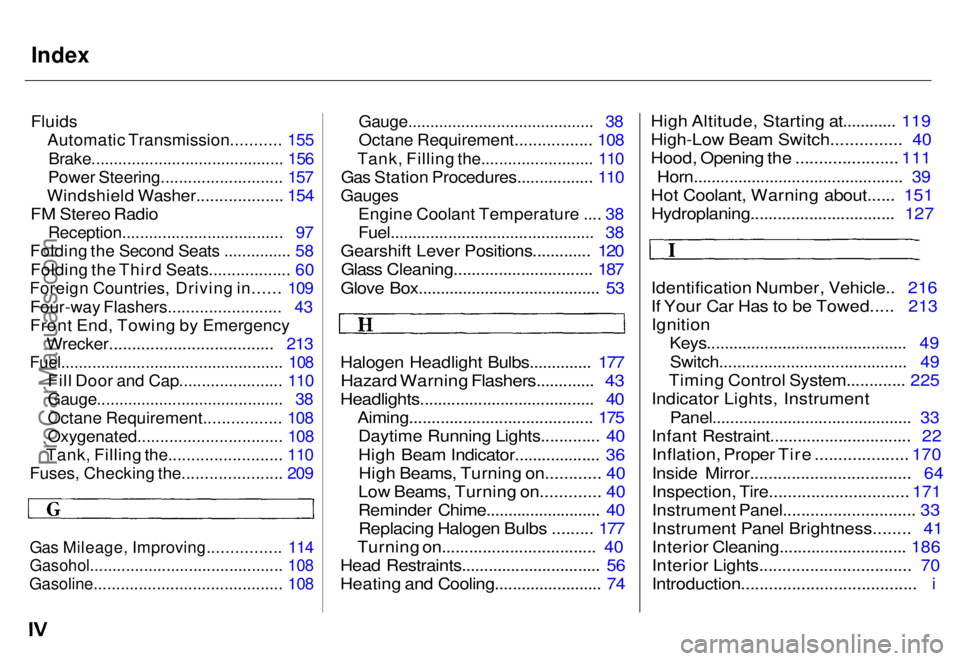
Index
Fluids
Automatic Transmission........... 155
Brake........................................... 156
Power Steering........................... 157
Windshield Washer................... 154
FM Stereo Radio
Reception.................................... 97
Folding the Second Seats ............... 58
Folding the Third Seats.................. 60
Foreign Countries, Driving in...... 109
Four-way Flashers......................... 43
Front End, Towing by Emergency
Wrecker.................................... 213
Fuel.................................................. 108
Fill Door and Cap....................... 110
Gauge.......................................... 38
Octane Requirement................. 108
Oxygenated................................ 108
Tank, Filling the......................... 110
Fuses, Checking the...................... 209
Gas Mileage, Improving................ 114
Gasohol........................................... 108
Gasoline.......................................... 108
Gauge.......................................... 38
Octane Requirement................. 108
Tank, Filling the......................... 110
Gas Station Procedures................. 110
Gauges Engine Coolant Temperature .... 38
Fuel.............................................. 38
Gearshift Lever Positions............. 120 Glass Cleaning............................... 187
Glove Box......................................... 53
Halogen Headlight Bulbs.............. 177
Hazard Warning Flashers............. 43
Headlights....................................... 40
Aiming......................................... 175Daytime Running Lights............. 40
High Beam Indicator................... 36High Beams, Turning on............ 40
Low Beams, Turning on............. 40
Reminder Chime.......................... 40 Replacing Halogen Bulbs ......... 177
Turning on.................................. 40
Head Restraints............................... 56
Heating and Cooling........................ 74 High Altitude, Starting at............ 119
High-Low Beam Switch............... 40
Hood, Opening the ...................... 111
Horn............................................... 39
Hot Coolant, Warning about...... 151 Hydroplaning................................ 127
Identification Number, Vehicle.. 216
If Your Car Has to be Towed..... 213Ignition
Keys............................................. 49
Switch.......................................... 49
Timing Control System............. 225
Indicator Lights, Instrument
Panel............................................. 33
Infant Restraint............................... 22 Inflation, Proper Tire .................... 170
Inside Mirror................................... 64
Inspection, Tire.............................. 171
Instrument Panel............................. 33
Instrument Panel Brightness........ 41
Interior Cleaning............................ 186
Interior Lights................................. 70
Introduction...................................... iProCarManuals.comMain Menu s t